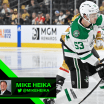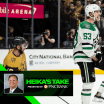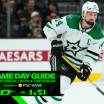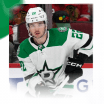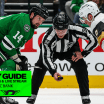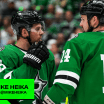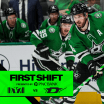The National Hockey League is filled with stories of teams that are able to put disastrous campaigns behind them and quickly move forward.
Colorado did so this season. The New Jersey Devils are a pleasant surprise this season after getting the No. 1 pick in last June's draft. Philadelphia had the No. 2 pick, one ahead of Dallas, and is in the postseason.
But there are also teams where losing becomes a kind of way of life.
Burnside: Entering offseason, what's next for Stars?
Dallas faces several question marks as it turns the page and looks toward 2018-19
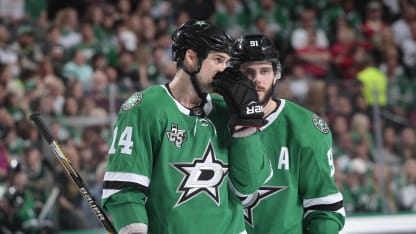
Edmonton is one of those teams with one playoff berth to their credit since appearing in the 2006 Stanley Cup final. Carolina has gone nine straight seasons without a playoff game since losing in the 2009 Eastern Conference final. And the Dallas Stars, who have now missed the playoffs in eight of the last 10 years, are in that category as well.
But this is also a Dallas team that is just three seasons removed from winning a Central Division title and advancing to Game 7 of the second round.
So, which is it? A team on the cusp or a team that has grown too accustomed to losing?
Here are five things to watch unfold in the coming weeks and months that should provide at least signs as to what may happen if not the outright answers.
1. A difficult season followed by difficult questions
The cost to a team like Dallas that misses the playoffs, especially in the fashion they did plummeting out of contention with a franchise-worst eight-game winless streak in March, is multi-fold.
Straight on dollars, missing the playoffs will cost Tom Gaglardi and his ownership group millions of dollars in playoff revenue. Millions. Then, there is the ripple effect of missing them on the casual fan who might have been taken in by the buzz surrounding a postseason run, and the ability to continue to attract free agents to a winning franchise -- not to mention attracting even more sponsors to a winning team and so on and so on.
In short, it sucks to miss and the cost is significant. And now, Gaglardi will have assess what kind of changes need to be made in order to rectify this situation and ensure it doesn't happen again.
Chief among those questions is whether to return both general manager Jim Nill and Ken Hitchcock. That's the first order of business in the coming days and weeks. In order for both men to continue in their current roles -- and we believe that is the best course of action, given the vast knowledge and commitment to winning both possess -- they must be more in sync than they were this season.
It's clear there was a disconnect on some levels about the structure of the team and what was needed as the season moved along, and especially when a key offseason addition -- center Martin Hanzal -- was lost for the season in early March. The belief that young players and prospects coming up from the American Hockey League would be able to step into significant roles proved to be misguided.
Jason Dickinson, the team's top center prospect, struggled while being given a long look after Hanzal's season ended with back fusion surgery in early March. Players like Brett Ritchie, Devin Shore, Remi Elie and Gemel Smith did not contribute enough offensively, so the assessment of whether those players need to be put in better situations to succeed or whether other assets need to be acquired has to be something both the GM and the coach agree on.
Further, there needs to a firm agreement on how young players like defenseman Julius Honka and last year's third-overall pick, Miro Heiskanen, are developed.
Hitchcock said Monday he feels he's done a nice job with young players historically, saying he knows when players are ready. The implication is clear -- he didn't think enough of the Stars young players were ready. And the results bear that out.
But beyond that, even the style of play the team will play must be something both sides are committed to and are in lockstep regarding.
In the end, that didn't happen this season, and it seems obvious that can't be allowed to happen moving forward.
Did we mention difficult questions?
2. Changing the culture
Whether the Stars want to admit it or not, they are among the least successful teams over the last decade when it comes to the postseason.
Eight times in the last 10 years they missed the postseason tournament. Some of that time was during the tumultuous ownership change era when the team was in bankruptcy before Tom Gaglardi purchased the team in November 2011. But since Nill was announced as GM in April 2013, the team has missed the playoffs in three of five years and won just one playoff series.
Nill was in Detroit for most of the team's record-breaking 25 straight years as a playoff team. When you heard the term "culture of winning" you thought of the Red Wings. The same cannot be said in Dallas.
What exactly does that culture look like? Well, a team with a culture of winning doesn't go on an eight-game winless streak in March and go from having an 80 percent chance of making the playoffs to a 1 percent chance.
They don't lose eight straight games in which they have a chance in the third period of every single one.
Is this a lack of leadership? The players must bear a significant responsibility for this letdown, regardless of moves that should have been made or coaching decisions that might have been made.
Captain Jamie Benn struggled at times, missing the net on key chances and taking ill-advised penalties. His point totals are exemplary, but there is more to leadership than just collecting points. This isn't to suggest this is Benn's fault, but if this team's leadership group couldn't find a way with so many games well within reach, it behooves Nill to find some players who will.
"That's a great question because, first of all, what is culture and a lot of time that's winning, but how do you win?" Nill said when we asked about the culture of this team. "You've got to create that. My biggest thing, I don't like excuses. We got to get out of the excuse part. And culture's a big word and it's about, sometimes some of these guys have to go through it, losing, before you do win. Now, you got to make sure that doesn't become (the culture). The culture can become a losing culture, too, and that's the fine line.
"That's what we got to figure out. That's what we're going to examine. And that's where this league is humbling. There's no passengers, and I don't think we're as bad as when you lose here these last few games. We're not as bad as maybe everybody sees it. Maybe we're not as good as I talked about that 20 to 60 games (of the season). Where are we at, and how do we get better from it?"
One thing is clear -- and maybe this goes to culture and maybe it doesn't -- but this Stars team was infinitely more difficult to play against than the one that was out of the playoff race early in the 2016-17 season, and credit Hitchcock for instilling that kind of commitment to team defense and work ethic in this squad.
3. Scoring wingers
We'll never know whether the addition of a player like Patrick Maroon, or Michael Grabner or Evander Kane -- or even a perennially underachiever like Thomas Vanek at the trade deadline would have paved the way to the playoffs for the Stars. It's a mug's game to suggest Kane's nine goals in 17 games for San Jose would have vaulted Dallas into the postseason because you never know if the fit is going to be the same, better or worse.
But what is clear is that those players all had positive impacts on teams they joined at the deadline and all those teams are still playing. And it seems abundantly clear that this Dallas team cannot contend with the big boys in the Western Conference without more balanced scoring.
In fact, it was interesting to hear Hitchcock say Monday that the team really needs to assess what it is those top teams in the Central Division -- Nashville and Winnipeg -- do well and try and emulate that as opposed to concentrating on how to make up the three points they were behind the eighth-place Colorado Avalanche.
Certainly, the hallmark of those two teams is their depth. And that means the Stars are going to have to find a way to attract some offense in the offseason or hold their breath (again) and hope that offense comes from within. Because it did not reveal itself when it was needed most in March as the Stars dipped to 18th in the league in scoring and tied for 25th in 5-on-5 scoring.
Depending on whether Hitchcock returns as head coach, the Stars are expected to try and trade Jason Spezza and the one year remaining on his contract at $7.5 million or buy him out of that final year after an eight-goal campaign.
Likewise, netminder Kari Lehtonen will likely move on (see below) and his $6.5 million will come off the books. Maybe Antoine Roussel, another potential unrestricted free agent, returns. But for a player who didn't score a goal after Dec. 23, his demands will have to be pretty modest to stay in Dallas.
In other words, there will be some salary cap relief for Nill, but he'll also have to start thinking about what it's going to cost to keep Tyler Seguin in the fold as the star center approaches the final year of his current deal.
Nill said he's optimistic Seguin will remain with the Stars and is hopeful a contract could be in place shortly after July 1.
Nill alluded to a number of potential trades that fell through before the deadline, so it's possible he will revisit those as the draft -- which will be held in Dallas in late June -- approaches. But whether it's a player with term like Max Pacioretty or a free agent like Rick Nash or Evander Kane, the Stars cannot consider themselves a legitimate contender until they find the depth scoring.
The lack thereof was a contributing factor to missing the playoffs this year.
4. Goaltending
A year ago when Nill acquired Ben Bishop from Los Angeles and signed him to a six-year deal, the belief was that the Stars had solved perhaps the most critical problem, which was their goaltending.
When we sat down with Bishop in training camp, we talked about the narrative that his health was an issue after he missed the playoffs with Tampa Bay in 2014, was hurt in the Stanley Cup final in 2015 and hurt again the Eastern Conference final the next year.
The good-natured Bishop bristled and pointed out his numbers were among the league leaders in games played, not to mention the fact he was twice nominated for the Vezina Trophy as the league's top netminder.
Fair enough.
He reiterated that on Monday.
"I feel fine. I think since I've became a starting goalie, I've played top 10 in the league in games played, so it's just kind of unfortunate it seems like it always kinds of happens at bad times," Bishop said. "If that happens the first month of the season and you get back within a month, no reason to be talking about it."
But the narrative is what it is as Bishop appeared in just two of the team's last 16 games as he twice injured his left knee.
If Bishop is healthy are the Stars a playoff team? We'll just say it: Yes, guaranteed. But the fact Lehtonen had to shoulder the load exclusively (Mike McKenna made one start) was too much for the veteran netminder who couldn't find enough saves in his repertoire to push the Stars into the postseason, losing eight of his last 11 decisions.
This isn't all on Lehtonen, of course. But if there was a strong belief for the first three quarters of the season that Lehtonen had earned a chance to come back as the Stars' backup at a reduced salary next year, that seems impossible now given the way the stretch run unfolded.
That means the Stars, who have good goaltending depth in the system with Jake Oettinger and Colton Point both earning rave reviews, but they are 19 and 20, respectively. So there is no one close to playing as a backup in the NHL.
Now, Nill must find a netminder who can back up Bishop. And whether it's fair or not, they must find a goaltender who might be able to step into the breach if Bishop is injured again.
5. Wait, there's still a baby in that bathwater
You know that old saying, right? Well, the Stars apply exactly because, let's be very candid: In spite of the crushing disappointment and the many questions the finish to this season leaves, there is still much, much to be enthusiastic about.
Bishop should be even better next year, provided he stays healthy. Maybe Hanzal comes back from the surgery.
But even if neither of those things happen, this is a team with a powerful core of high-end assets starting with Seguin, who hit the 40-goal mark for the first time in his career, but more importantly, assumed the duties of a true, elite No. 1 NHL center.
He killed penalties for the first time. He played in key moments, taking key draws, throughout the season. He rose to the challenge provided by Hitchcock and his staff and is now the emotional core of this team.
Unless things go completely off the rails, he'll be a Star for the next decade at least.
Benn and Alexander Radulov made up the other parts of what was for most of the season the NHL's most imposing forward line when Hitchcock used them as a trio. He often split them on the road because of the team's lack of depth, but when together, the three were a treat to watch.
Radulov, in the first year of his five-year deal, was a dervish -- his enthusiasm contagious for the rest of the team. And if, as the Stars hope, erstwhile prospect Val Nichushkin returns next season from the Kontinental Hockey League, expect Radulov to become an important mentor as he was for many of the young players this season.
Equally impressive for us was the play and maturity of John Klingberg, who rightfully entered the Norris Trophy discussion until the team's late-season swoon out of the playoffs.
He will only get better as he becomes physically more mature, but he took a giant leap this season under Hitchcock and assistant coach Rick Wilson, simplifying his game and understanding the nuances of when to push and when to pull back. He also became an important, vocal voice in the Dallas locker room.
With Stephen Johns' emergence this season before a late-season concussion and the steadiness of Esa Lindell, there is much to like about the Dallas blue line.
Speaking of the sky and its limits as it relates to the Dallas blue line, it will be fascinating to see how Heiskanen fits into the plan moving forward.
This season saw the 18-year-old Finnish sensation play at the World Junior Championships, the Olympics and then in the playoffs with the Finnish Elite League. He is also expected to take part in the World Championships this summer.
Can he step into the Dallas lineup from the get-go? Will he take some time in Cedar Park at the American Hockey League level?
How this key asset is developed is as important as any asset since perhaps Mike Modano came with the team from Minnesota.
This story was not subject to the approval of the National Hockey League or Dallas Stars Hockey Club.




